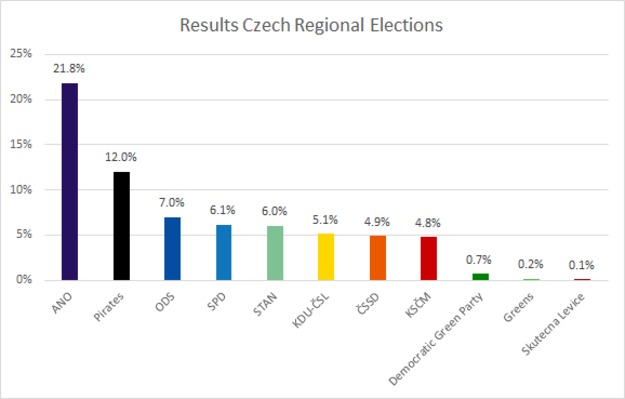Elections to regional councils in the Czech Republic were held in 13 regions (except Prague) on 7 and 8 October 2016*. In one third of constituency’s were together with Czech senate elections. In general the results show clear loss for both traditional left-wing parties as well as traditional right-wing parties across Czech Republic.
A total of 7,399,299 voters were eligible to vote and 2,769,361 votes were cast. Despite the worsening coronacrisis, the voter turnout was above average, as the second-highest in the regions’ history since the turn of the century (38%).
In most regions, the biggest trend was to try to weaken the ANO movement as much as possible. Lots of candidates were encouraged by this objective to form coalitions. This in preparation for the parliamentary elections in autumn 2021, when an anti-Babiš bloc is going to be formed.

ANO 2011 – "Action of Dissatisfied Citizens" (Czech: Akce nespokojených občanů, ANO), "Ano" means "yes" in Czech, centrist;
Piráti – The Czech Pirate Party (Czech: Česká pirátská strana), a liberal, centrist political party;
ODS – Civic Democratic Party (Czech: Občanská demokratická strana), liberal-conservative;
SPD – Freedom and Direct Democracy – Tomio Okamura (Czech: Svoboda a přímá demokracie – Tomio Okamura) is a Eurosceptic, anti-immigration, pro-direct democracy political party in the Czech Republic;
STAN – Starostové a nezávislí (Mayors and Independents) is a Czech political party focused mainly on localism, promoting community involvement of municipalities and regions; liberal, centrist party.
ČSSD – The Czech Social Democratic Party (Czech: Česká strana sociálně demokratická), social-democratic;
KDU-ČSL – Christian and Democratic Union – Czechoslovak People’s Party (Czech: Křesťanská a demokratická unie – Československá strana lidová, Christian-democratic;
KSČM – Communist party of Bohemia and Moravia; radical left;
Skutecna Levice – "the Real Left", newly founded radical left-wing party;
Results in the regions (range)
KSČM 3.22-6.26%, average 4.75%;
ČSSD 2.16-11.86%, average 4.92%;
ANO 17.85-30.24%, average 21.83%;
Pirates 9.86%-14.41%, average 12.03%;
SPD 4.63-8.94%, average 6.14%.
In all regions, the following parties ran individually: ANO, SPD, Pirates (in one region they ran in a two-member coalition), KSČM, ČSSD (individually in 10 regions + 3 regions in a coalition). All other parties were in coalitions, at least in some regions.
The KSČM has had a governor (regional supreme representative) in at least one region for the last 8 years, but now there will be none. The ČSSD had 5 governors, and now it will have only one as well.
Mandates compared to the 2016 elections
ANO: 178 (+2)
Pirates 91: (+88)
ODS 53: (-23)
STAN 40: (+16)
SPD 35: (+33)
KDU-ČSL: 33 (-9)
ČSSD: 28 (-97)
KSČM: 13 (-73)
Greens: 0 (4 seats for the coalition with the ČSSD);
Election Campaigns
The election campaigns were impacted by quarantine restrictions. From the traditional left-wing parties, the ČSSD was far more active in terms of PR. According to PR experts, the KSČM had a very dull campaign. The newly-formed Skutecna Levice party tried a contact-based, activist campaign in the region where it ran.
The ČSSD experienced an internal party crisis in some regions, with certain groups of officials splitting off and then running separately (with only partial success). The KSČM managed to compile fully-fledged candidacies in all regions, with a relatively acceptable average age of 53 (although the average age of the membership base is significantly higher). The KSČM also had an average number of women candidates – 26.4% (compared to 27.5% overall), and 5.22% were young candidates under the age of 29 (compared to 8.47% overall).